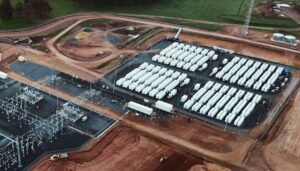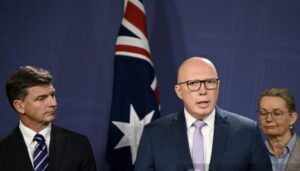
If the South Australian government and energy consumer thought they might get some help from competition regulators to keep a cap on wholesale electricity prices, they are going to be disappointed. The chief regulator says he has no problems with them exercising their market power.
Electricity prices soared in South Australia in late June and July, a result of soaring gas prices, high demand, interconnector repairs and bidding pattern of the few generators that control the market.
Reports from RenewEconomy contributor David Leitch, the Melbourne Energy Institute and the Climate Council have all pointed to price gouging and a huge increase in margin by the big market players, particularly AGL Energy which has a dominant position in the local market.
That’s all OK for Rod Sims, the head of the Australian Competition and Consumer Commission.
“I think the energy market does allow people when they’re in that position to price they way they want. That’s how the market works,” Sims told an energy users’ conference in Melbourne, according to the Australian Financial Review.
“It’s not illegal to use your market power. We should never criticise people for using their market power, because you and I would do it as well,” Sims said. (Ed: Um, isn’t that what the ACCC is supposed to regulate?).
Indeed, the ACCC forecast exactly this outcome in 2007, when it allowed AGL to purchase both the Torrens A and Torrens B gas generators near Adelaide (collectively known as TIP), giving the company control of around 80 per cent of average demand in the state, in addition to its 70 per cent share of the retail market.
In it assessment, the ACCC said owning Torrens would give AGL the the ability and incentive to “bid strategically” and raise prices in the wholesale market significantly. It allowed the purchase, and that is exactly what AGL did.
In a report on major price pikes that occurred soon after that purchase, in early January 2008, the Major Energy User group said the ability of TIPS to set prices at both ends of the supply chain gives AGL “an exceptionally dominant” position.
“This allows the raising of pool prices above competitive levels to maximize revenue. It also allows the raising of retail price contracts and the costs of hedge contracts with competing retailers and large customers.”


This graph from the AER also points to the contribution of “rebidding” to the jump in wholesale prices. Note the red line in early 2015, which is Queensland, an event that the Queensland Productivity Commission noted added $170 million to market cost due to the bidding behaviour of a few government-owned generators.
The latest bidding in South Australia, reports last week noted here and here, resulted in a huge increase in margins and an additional $170-$190 million in revenue, at the cost of any poor user or small retailer that was not properly hedged.
AGL has defended its actions, and Origin Energy, the other big player in the market, has said that what happened in the South Australia market was entirely normal, and perfectly predictable.
And, although the AER has yet to produce its reports into the three really high prices events, when average prices over a 30-minute period soared to as high as $9,000/MWh, it all seems good with the competition regulator.
Even though the ACCC anticipated the reduction in competition in South Australia’s energy markets nearly a decade ago, and identified the market power it could hold over both the wholesale and retail markets, it waived through the purchase of TIPS in any case.
The Major Energy Users were damming, noting that it was then nearly impossible for big energy users to obtain contracts from retailers, and they were exposed to those big spikes in spot prices. It said the ACCC decision was wrong and based on “incorrect data or inadequate analysis.”
“Effectively, TIPS used its undoubted position of market power in the supply arrangements and the Rules to their maximum benefit, in order to create an apparent shortage of supply. Whether this was done through strategic bidding, or even rebidding, the TIPS approach is unique to it, due to its dominance as the largest generator in the SA region.
“This approach by TIPS is analogous to any supplier in the market attempting to drive up prices. If the supplier can effectively create an artificial shortage of a needed product with no scope for demand responses then by doing so, it can drive prices up.”
It asked the ACCC and the AER to “implement actions to prevent AGL/TIPS from repeating its use of this undoubted market power in the future.”
They didn’t, and they seem fine with that. To add insult to injury, Sims is now pretending it’s the fault of renewables, even though the issues of market power were identified a decade ago before much had been built.
According to the AFR, Sims quoted “studies” that suggested that once renewable got to a certain level in a market “it causes issues”.
The AFR quoted him saying the rapid expansion of renewable wind and solar energy in South Australia had created problems for traditional fossil fuel generators because it came onto the market at zero cost, and some players had sold their gas to Queensland’s liquefied natural gas industry.
“There’s just less players around. And those people left standing may well have contingent market power because they’re needed at certain times,” Sims said.
That will be no comfort to the South Australian government or energy consumers. The issue is competition, and the sooner a new interconnector can be built and/or market rules re-written that provide a market incentive for faster, cheaper and clean technologies to replace the ageing, slow response gas generators currently in the market, the better.
The issue, we are told, was raised at the energy ministers forum in Canberra last week, many of whom were concerned that electricity markets were being “held hostage” by a small number of gas-fired generators.
The South Australia minister lamented the fact that the biggest and dirtiest plant in the grid (TIPS) should be rewarded in current market conditions.
More tellingly, the ministers lamented how poorly served the energy markets were by the regulators, who either could not see the pace of technology change (in the case of the AEMO, which said battery storage was up to two decades away), were too slow to react (the AEMC), or had no bite (the AER).
As RenewEconomy has noted on many occasions, these are not the only regulatory weaknesses, which are particularly exposed in state based regulators view of electricity pricing and the contribution to solar. The ACCC seems to have reinforced that point: consumers are being failed again.










